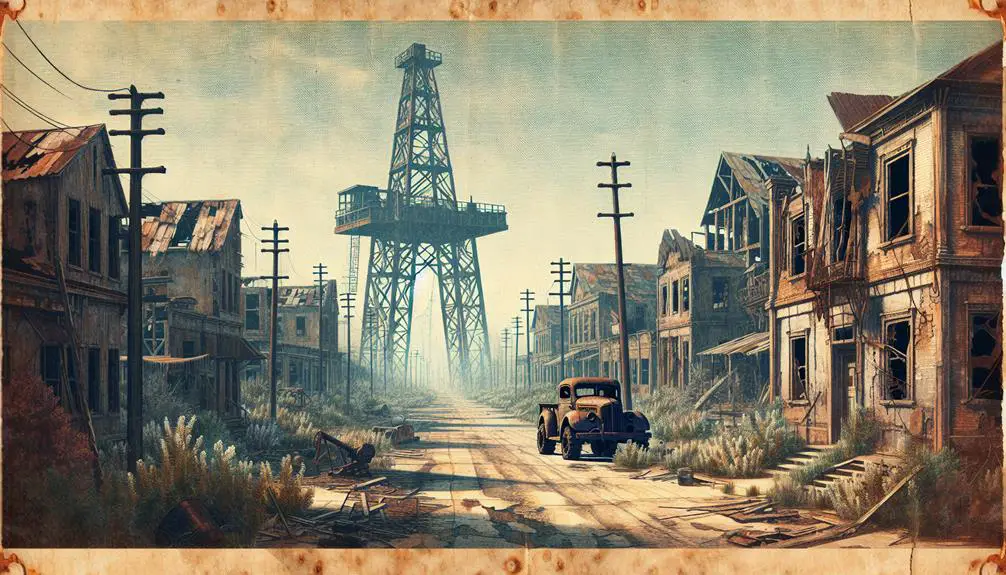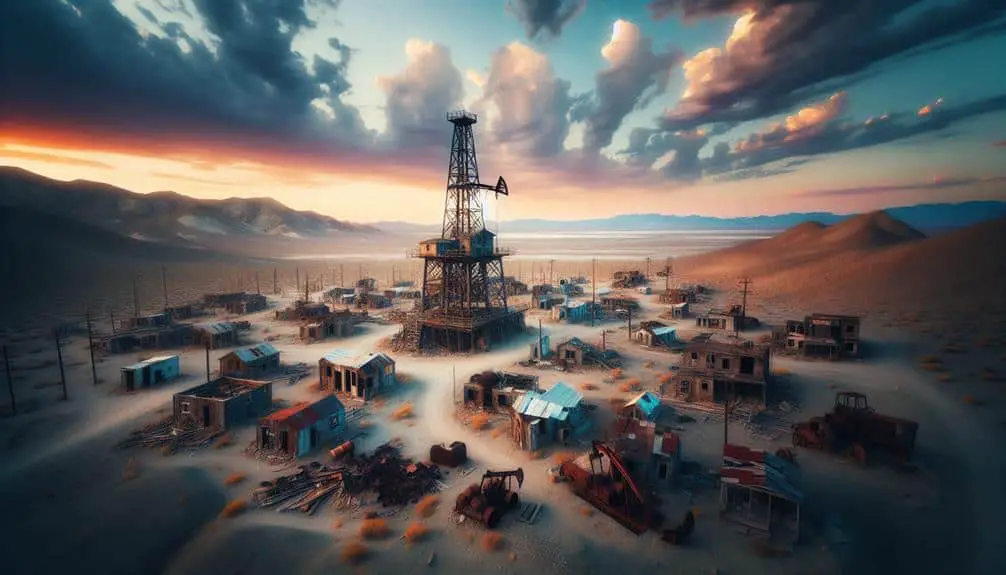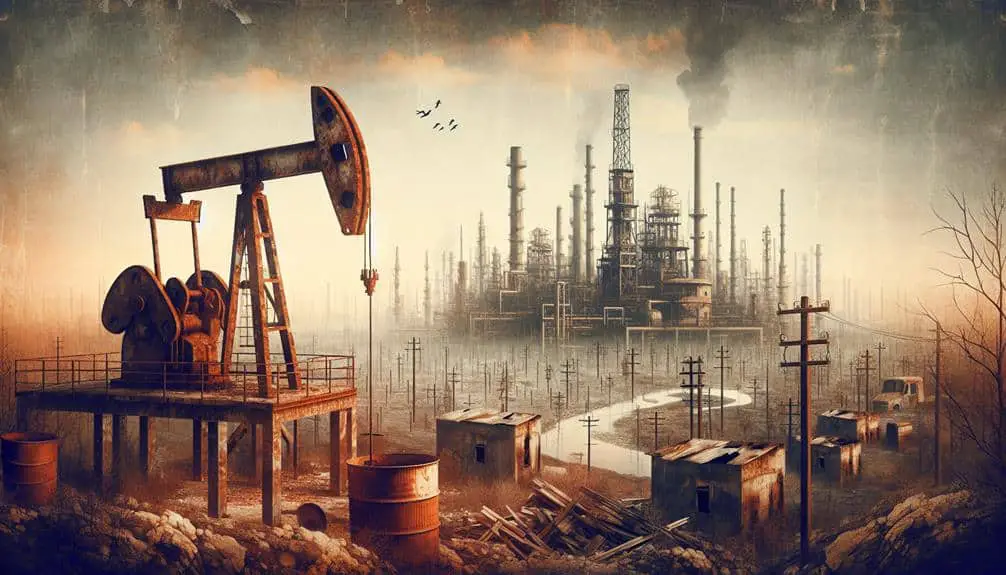Explore the eerie remnants of America's abandoned oil towns shaped by boom and bust cycles. Discover how economic fluctuations and environmental impacts led to the desertion of once-thriving communities. Uncover the architectural relics and artifacts that whisper tales of a bygone era. Learn about preservation efforts aiming to revitalize these ghost towns and create sustainable futures. Each town holds a unique history waiting to be unraveled, showcasing the cautionary tale of unchecked growth and the importance of sustainable practices for the future.
Key Points
- Oil booms and busts shaped economic landscapes.
- Architectural remnants reveal past prosperity and decline.
- Environmental degradation impacted communities' sustainability.
- Social disruption from transient oil workers affected towns.
- Preservation efforts aim to revitalize and attract tourists.
Origins of Forgotten Oil Towns
The birth of forgotten oil towns across the USA can be traced back to the late 19th century when the oil industry began its rapid expansion. Early settlers, seeking new opportunities in the wake of the industrial revolution, ventured into uncharted territories in search of oil-rich lands. As these settlers discovered oil reserves, makeshift settlements sprang up almost overnight, giving rise to what would later become bustling oil towns.
During the industrial revolution, the demand for oil skyrocketed, driving further exploration and extraction efforts. This surge in activity led to the establishment of more oil towns, attracting a diverse population keen to capitalize on the newfound resource. The rapid growth of these towns mirrored the frenzied pace of the oil industry, with infrastructure hastily constructed to support the booming oil economy.
As the oil industry flourished, these towns became vibrant hubs of activity, teeming with workers, businesses, and social establishments. However, as technological advancements and shifts in the oil market occurred, many of these once-thriving towns eventually faded into obscurity, leaving behind a legacy of forgotten prosperity.
Impact of Oil Booms and Busts
Amidst the rise and fall of forgotten oil towns in the USA, the Impact of Oil Booms and Busts reverberates through the historical landscape, shaping communities and economies. The economic fluctuations brought by oil booms and busts have left lasting imprints on these towns. During booms, rapid growth and prosperity transformed once-sleepy settlements into bustling hubs, attracting migrants seeking employment and opportunities. However, the subsequent busts led to mass layoffs, abandoned infrastructure, and economic downturns, causing distress and upheaval among residents.
Moreover, the environmental repercussions of oil activities have had long-term effects on these towns. Spills, pollution, and resource depletion have scarred the land, impacting ecosystems and public health. The legacy of these environmental damages continues to haunt these abandoned oil towns, serving as a stark reminder of the costs associated with rapid industrialization and unchecked exploitation.
In essence, the Impact of Oil Booms and Busts serves as a cautionary tale, highlighting the interconnectedness of economic prosperity and environmental sustainability in shaping the fates of communities built on the promise of black gold.
Architectural Remnants and Artifacts
Exploring the remnants of architecture and artifacts in these abandoned oil towns reveals a tangible glimpse into the past prosperity and subsequent decline that once defined these landscapes. Ghost towns dotted with industrial relics stand as silent witnesses to the bustling activity that once filled their streets. The skeletal frames of old refineries loom large against the horizon, their rusted pipes and machinery whispering tales of a bygone era.
Walking through these deserted streets, you can't help but feel a sense of eeriness mixed with awe at the resilience of these structures. Dilapidated houses with peeling paint and broken windows serve as a stark reminder of the families that once called this place home. The remnants of old storefronts and saloons evoke images of a bustling community now lost to time.
Every abandoned oil town holds its own unique collection of architectural remnants and artifacts, each telling a different story of boom and bust. These ghost towns offer a glimpse into a past era of industrial fervor, now frozen in time, waiting to be explored by the curious traveler seeking a deeper understanding of America's industrial history.
Decline and Desertion of Oil Towns
Strolling through the remnants of architecture and artifacts in deserted oil towns reveals not just a snapshot of the past prosperity but also a stark narrative of the decline and abandonment that has defined these once-thriving hubs of industry. As you explore these abandoned sites, you witness the aftermath of a tumultuous history marked by environmental consequences and social upheaval. Here are some key factors contributing to the decline and desertion of oil towns:
- Boom and Bust Cycles: The oil industry's volatile nature led to rapid economic fluctuations, causing towns to flourish during booms but struggle during busts.
- Technological Advances: Advancements in drilling technology shifted the industry landscape, rendering some oil towns obsolete as operations moved elsewhere.
- Environmental Degradation: Unregulated drilling practices often resulted in pollution, impacting both the environment and local communities.
- Social Disruption: The transient nature of oil workers and the influx of laborers led to social tensions, affecting the fabric of these towns.
Understanding the complex interplay of these factors is important to grasping the full narrative behind the decline of these once-vibrant oil towns.
Preservation Efforts and Future Prospects
Efforts to preserve and revitalize abandoned oil towns in the USA are essential for maintaining historical heritage and exploring potential sustainable futures for these once-thriving communities. Revitalization initiatives play an important role in preserving the unique identity and cultural significance of these towns, attracting tourists, historians, and investors interested in the rich history they hold. By repurposing old infrastructure and buildings, these towns can be transformed into hubs for cultural events, museums, or eco-friendly businesses, fostering economic diversification and creating new opportunities for local residents.
Future prospects for these towns lie in sustainable development practices that align with modern environmental standards. Embracing renewable energy sources, promoting eco-tourism, and investing in green technologies can pave the way for a more resilient and prosperous future. Collaborative efforts between government agencies, private investors, and local communities are key to driving these towns towards a path of sustainable growth and prosperity, ensuring that their legacy endures for generations to come.
Frequently Asked Questions
How Did the Discovery of Oil Impact the Local Wildlife and Ecosystem in Abandoned Oil Towns?
When oil was discovered, wildlife felt the tremors of change. The ecosystem suffered, degraded by spills and pollution. The impact on wildlife was profound, causing a ripple effect that forever altered the delicate balance of nature.
What Role Did the Federal Government Play in the Rise and Fall of These Oil Towns?
The federal government played a pivotal role in the rise and fall of these oil towns. Government intervention influenced economic development but also led to environmental impact and community displacement. The delicate balance remains a critical aspect of these towns' histories.
Are There Any Ghost Stories or Urban Legends Associated With the Abandoned Oil Towns?
Step into the forgotten world of abandoned oil towns, where whispers of paranormal experiences echo through haunted buildings. Local folklore weaves tales of mysterious disappearances, leaving a chilling legacy in these desolate landscapes.
Have Any Famous Historical Figures or Celebrities Visited These Forgotten Oil Towns?
Historical figures and celebrities have made their mark on these forgotten oil towns through exploration. Their visits shed light on the wildlife impact and historical significance of these areas, adding depth to their stories.
What Is the Current Legal Status of the Land in These Abandoned Oil Towns and Who Owns Them Now?
You own the answer to the current legal status of the land in those abandoned oil towns. Current ownership shows a mix of private and public entities. Conservation efforts aim to preserve history while balancing economic interests.



